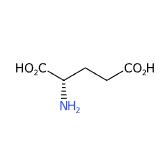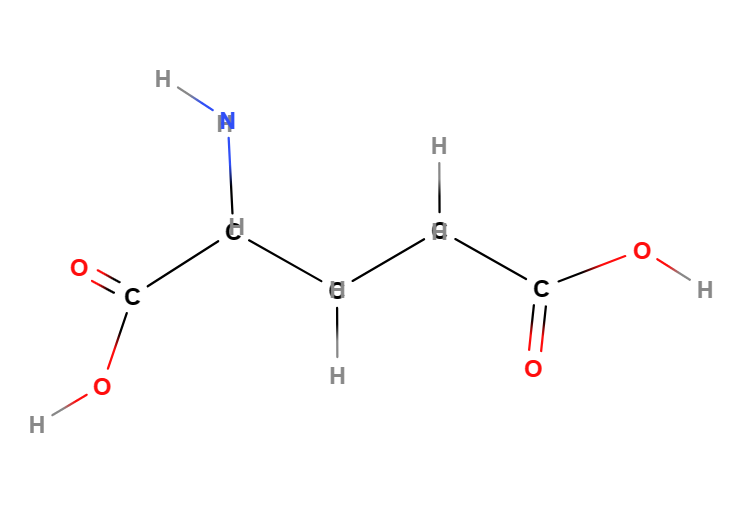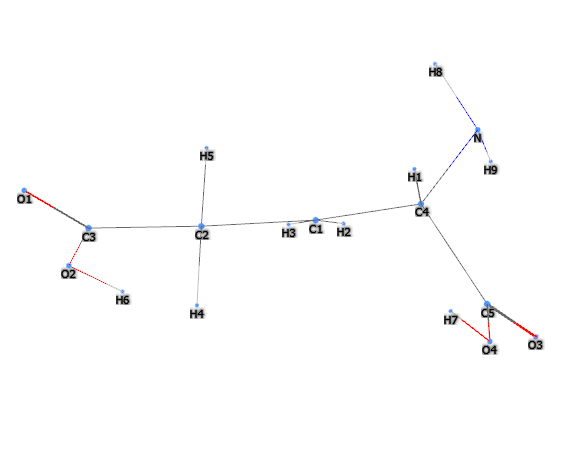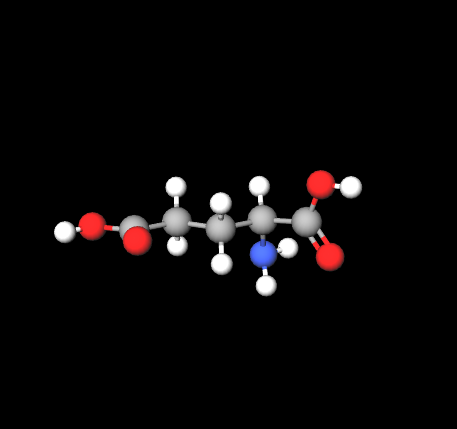| "Descrizione" by CarPas (5257 pt) | 2023-Apr-22 19:38 |
Review Consensus: 10 Rating: 10 Number of users: 1
| Evaluation | N. Experts | Evaluation | N. Experts |
|---|---|---|---|
| 1 | 6 | ||
| 2 | 7 | ||
| 3 | 8 | ||
| 4 | 9 | ||
| 5 | 10 |
E620 (Glutamic acid) is an amino acid that occurs naturally and in the human body and is in close correlation with glutamine which regulates the balance of the skin. It is an α-amino acid.
Amino acids play a key metabolic function in the human body and are constituents of proteins.
As food additives they perform different functions: preservatives, flavour enhancers, food supplements and more.
Amino acids together with their salts are used in cosmetics as conditioning agents for both hair and skin (e.g. as moisturisers and other similar functions). Moisturisers are different in nature: the best are the natural ones that exploit the mechanism of integration between the ingredient and the skin by moisturising the horny hydrolipid film, i.e. the thin protective layer that covers the epidermis protecting it from harmful external microbes, keeping the skin moisturised and supple and its pH or acidity value between 4 and 6. Then there are the occlusive moisturisers, usually derived from petroleum (Paraffinum, Paraffinum liquidum and others), but also triglycerides, lanolin oil, natural or synthetic waxes, fatty acid esters and others that create an artificial occlusive layer on the stratum corneum of the skin with the advantage of accelerating the protective process but with the disadvantage of preventing the skin's natural transpiration.
α-amino acids that have similar physical structures undergo similar changes with regard to solubility in water/ethanol mixtures, and technologies to separate α-amino acids from industrial residues, which may not even be innocuous, are constantly being improved. However, many data on the solubility in water-ethanol and ethanol of some α-amino acids are contradictory or even lacking, and the effects of ethanol on the solubility of amino acids may be different. Overall, the scientific literature considers that α-amino acids do not pose significant problems for human health when taken orally, except in people with certain genetic diseases.
Industrially it appears in the form of a white powder.

What it is used for and where
In the plant world, it regulates the growth of plants (1).
Food
Ingredient included in the list of European food additives as E620 with the function of flavour enhancer, in practice to improve flavour.
Food safety: amino acid α generally considered safe.
Animal feeding
In animal nutrition, used as a food supplement, it improves the quality of meat (2).
Some glutamic acid derivatives have shown efficacy in blood and brain circulation in animals undergoing stress (3).
Medicine
The objective of the article is to highlight various roles of glutamic acid like endogenic anticancer agent, conjugates to anticancer agents, and derivatives of glutamic acid as possible anticancer agents. Besides these emphases are given especially for two endogenous derivatives of glutamic acid such as glutamine and glutamate. Glutamine is a derivative of glutamic acid and is formed in the body from glutamic acid and ammonia in an energy requiring reaction catalyzed by glutamine synthase. It also possesses anticancer activity. So the transportation and metabolism of glutamine are also discussed for better understanding the role of glutamic acid. Glutamates are the carboxylate anions and salts of glutamic acid. Here the roles of various enzymes required for the metabolism of glutamates are also discussed (4).
Animal studies have shown that glutamine supplementation may decrease colon carcinogenesis, but any relation with glutamine or its precursors has not been studied in humans. The primary aim of this study was to assess whether dietary glutamic acid intake was associated with colorectal cancer (CRC) risk in community-dwelling adults. A secondary aim was to evaluate whether the association could be modified by the body mass index (BMI). Our data suggest that baseline dietary glutamic acid intake is associated with a lower risk of developing CRC, but this association may be mainly present in nonoverweight subjects (5).
Throughout the history of human civilizations, cancer has been a major health problem. Its treatment has been interesting but challenging to scientists. Glutamic acid and its derivative glutamine are known to play interesting roles in cancer genesis, hence, it was realized that structurally variant glutamic acid derivatives may be designed and developed and, might be having antagonistic effects on cancer. The present article describes the state-of-art of glutamic acid and its derivatives as anticancer agents. Attempts have been made to explore the effectivity of drug-delivery systems based on glutamic acid for the delivery of anticancer drugs. Moreover, efforts have also been made to discuss the mechanism of action of glutamic acid derivatives as anticancer agents, clinical applications of glutamic acid derivatives, as well as recent developments and future perspectives of glutamic acid drug development have also been discussed (6).
This study presents an efficient lead ion removal from water by a novel chitosan gel-based sorbent modified with glutamic acid ionic liquid (7).
Cosmetics
Moisturising and adsorbing. In clinical studies it showed water retention capacity and inhibited the growth of certain bacteria. It is biodegradable, water-soluble and non-toxic to humans and the environment.
Antistatic agent. Static electricity build-up has a direct influence on products and causes electrostatic adsorption. The antistatic ingredient reduces static build-up and surface resistivity on the surface of the skin and hair.
Hair conditioning agent. A significant number of ingredients with specific and targeted purposes may co-exist in hair shampoo formulations: cleansers, conditioners, thickeners, matting agents, sequestering agents, fragrances, preservatives, special additives. However, the indispensable ingredients are the cleansers and conditioners as they are necessary and sufficient for hair cleansing and manageability. The others act as commercial and non-essential auxiliaries such as: appearance, fragrance, colouring, etc. Hair conditioning agents have the task of increasing shine, manageability and volume, and reducing static electricity, especially after treatments such as colouring, ironing, waving, drying and brushing. They are, in practice, dispersants that may contain cationic surfactants, thickeners, emollients, polymers. The typology of hair conditioning agents includes: intensive conditioners, instant conditioners, thickening conditioners, drying conditioners. They can perform their task generally accompanied by other different ingredients.
Humectant. Hygroscopic compound used to minimise water loss in the skin and to prevent it from drying out by facilitating faster and greater absorption of water into the stratum corneum of the epidermis. The epidermis is the most superficial of the three layers that make up human skin (epidermis, dermis and hypodermis) and is the layer that maintains hydration in all three layers. In turn, the epidermis is composed of five layers: horny, the most superficial, granular, spinous, shiny, and basal. Humectants have the ability to retain the water they attract from the air in the stratum corneum and have the function of moisturising the skin. They are best used before emollients, which are oil-based.
The most relevant studies on this ingredient have been selected with a summary of their contents:
 |  |
 |  |
- Molecular Formula :C5H9NO4
- Molecular Weight 147.13
- CAS 56-86-0 6899-05-4
- EC number 200-293-7
Synonyms: (2S)-2-Aminopentanedioic acid; L-Glutaminic acid; Glutaminol; Glutamicol; Acidum glutamicum; Poly-L-glutamate
References_________________________________________________________________________
(1) Zhang L, Yang X, Gao D, Wang L, Li J, Wei Z, Shi Y. Effects of poly-γ-glutamic acid (γ-PGA) on plant growth and its distribution in a controlled plant-soil system. Sci Rep. 2017 Jul 20;7(1):6090. doi: 10.1038/s41598-017-06248-2.
(2) Hu CJ, Jiang QY, Zhang T, Yin YL, Li FN, Deng JP, Wu GY, Kong XF. Dietary supplementation with arginine and glutamic acid modifies growth performance, carcass traits, and meat quality in growing-finishing pigs. J Anim Sci. 2017 Jun;95(6):2680-2689. doi: 10.2527/jas.2017.1388.
(3) Perfilova VN, Popova TA, Prokofiev II, Mokrousov IS, Ostrovskii OV, Tyurenkov IN. Effect of Phenibut and Glufimet, a Novel Glutamic Acid Derivative, on Respiration of Heart and Brain Mitochondria from Animals Exposed to Stress against the Background of Inducible NO-Synthase Blockade. Bull Exp Biol Med. 2017 Jun;163(2):226-229. doi: 10.1007/s10517-017-3772-4.
(4) Dutta S, Ray S, Nagarajan K. Glutamic acid as anticancer agent: An overview. Saudi Pharm J. 2013 Oct;21(4):337-43. doi: 10.1016/j.jsps.2012.12.007. Review.
(5) Viana Veloso GG, Franco OH, Ruiter R, de Keyser CE, Hofman A, Stricker BC, Kiefte-de Jong JC. Baseline dietary glutamic acid intake and the risk of colorectal cancer: The Rotterdam study. Cancer. 2016 Mar 15;122(6):899-907. doi: 10.1002/cncr.29862. Epub 2015 Dec 30.
(6) Ali I, Wani WA, Haque A, Saleem K. Glutamic acid and its derivatives: candidates for rational design of anticancer drugs. Future Med Chem. 2013 May;5(8):961-78. doi: 10.4155/fmc.13.62.
(7) Ren H, Li B, Neckenig M, Wu D, Li Y, Ma Y, Li X, Zhang N. Efficient lead ion removal from water by a novel chitosan gel-based sorbent modified with glutamic acid ionic liquid. Carbohydr Polym. 2019 Mar 1;207:737-746. doi: 10.1016/j.carbpol.2018.12.043.
| Evaluate |
